Tea Horse Road
The Tea Horse Road or chamadao (simplified Chinese: 茶马道; traditional Chinese: 茶馬道), now generally referred to as the Ancient Tea Horse Road or chamagudao (simplified Chinese: 茶马古道; traditional Chinese: 茶馬古道) was a network of caravan paths winding through the mountains of Sichuan, Yunnan and Tibet in Southwest China.[1] This was also a tea trade route. It is also sometimes referred to as the Southern Silk Road or Southwest Silk Road, and it is part of a complex routes system connecting China and South Asia.

There are numerous surviving archaeological and monumental elements, including trails, bridges, way stations, market towns, palaces, staging posts, shrines and temples along the route. Besides the route's importance for commercial activity, more significantly it was crucial for cultural exchange between the Indian subcontinent, Tibet and Southwest China. Especially, it was vitally important for the interchange of Buddhism between China and South Asia.[2]
History
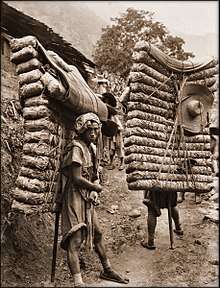
Sichuan and Yunnan are believed to be the first tea-producing regions in the world. The first record of tea cultivation in the world suggested that tea was cultivated on Sichuan's Mount Mengding (蒙顶山) between Chengdu and Ya'an earlier than 65 BC. Ya'an has been an important hub of tea trading till the 20th century. Besides tea, silk products from Chengdu, notably Shujin (蜀锦), was also traded through this road to South Asian from around 2000 years ago.
From around a thousand years ago, the Tea Horse Road was a trade link from Yunnan to Bengal via Myanmar; to Tibet; and to Central China via Sichuan Province.[3][4][5][6][7] In addition to tea, the mule caravans carried salt. Both people and horses carried heavy loads, the tea porters sometimes carrying over 60–90 kg (132-198 lb.), which was often more than their own body weight in tea.[8][9][10] The porters carried metal-tipped staffs, both for balance while walking and to help support the load while they rested, so they didn't need to lay the bales down (as illustrated in the photo).
It is believed that it was through this trading network that tea (typically tea bricks) first spread across China and Asia from its origins in Pu'er county, near Simao Prefecture in Yunnan.[11][12]
The route earned the name Tea-Horse Road because of the common trade of Tibetan ponies for Chinese tea, a practice dating back at least to the Song dynasty, when the sturdy horses were important for China to fight warring nomads in the north.[13]
Future
In the 21st century, the legacy of the Tea-Horse Road has been used to promote a railway that will connect Chengdu to Lhasa. This planned railroad, part of the PRC's 13th 5-Year Plan, is called the Sichuan-Tibet railway (川藏铁路); it will connect cities across the route including Kangding. Authorities claim it will bring great benefit to the people's welfare.[14]
Gallery
- Feixiange Grottoes (689 AD), Buddhist art on the route from Chengdu to Ya'an.
- The Royal Tea Garden, named by Emperor Xiaozong of Song (1186 AD) on Mount Mengding. Mount Mengding is the place where tea was first cultivated with written records (65 BC).
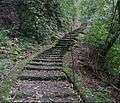 The surviving ancient route in Pujiang between Chengdu and Ya'an.
The surviving ancient route in Pujiang between Chengdu and Ya'an. The historical site of Ganxipo Posthouse on the route in Tianquan, Sichuan.
The historical site of Ganxipo Posthouse on the route in Tianquan, Sichuan. The official tea warehouse of Tea Horse Bureau (Qing Dynasty) on the route in Tianquan, Sichuan.
The official tea warehouse of Tea Horse Bureau (Qing Dynasty) on the route in Tianquan, Sichuan. The stone pagoda of Shita Temple (1169 AD) on the route from Chengdu to Ya'an.
The stone pagoda of Shita Temple (1169 AD) on the route from Chengdu to Ya'an.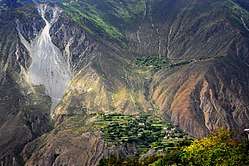 Markham County in the very east of Tibet. In this region, near upper Mekong, there was the junction of the Sichuan and Yunnan branches of the route.
Markham County in the very east of Tibet. In this region, near upper Mekong, there was the junction of the Sichuan and Yunnan branches of the route.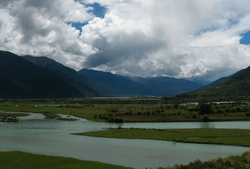
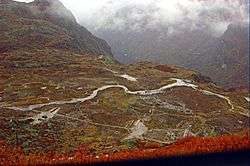
See also
- Tea
- Pu-erh tea
- Mengding Ganlu tea
- Shaxi, Yunnan, a well-preserved historical trading town in Jianchuan County on the ancient tea route
- Siberian Route
- Silk Road
- Jeff Fuchs, the first westerner to walk the entire road
References
- Forbes, Andrew, and Henley, David: Traders of the Golden Triangle (A study of the traditional Yunnanese mule caravan trade). Chiang Mai. Cognoscenti Books, 2011.
- Williams, Tim, Lin, Roland Chih-Hung and Gai, Jorayev. Final Technical Report on the results of the UNESCO/Korean Funds-in-Trust Project: Support for the Preparation for the World Heritage Serial Nomination of the Silk Roads in South Asia, 2013–2016.
- "Horse Corridor in Heaven". Shambhalatimes.org. 2010-01-18. Retrieved 2011-11-18.
- "Tea-Horse Route". Chinatrekking.com. Retrieved 2011-11-18.
- "The road line of the ancient tea-and-horse trade road". Yellowsheepriver.com. Retrieved 2011-11-18.
- "Richness, Diversity and Natural Beauty on the Tea Horse Road". English.cri.cn. Retrieved 2011-11-18.
- "Strange Brew:The Story of Puer Tea 普洱茶". Retrieved 2011-11-28.
- "Between Winds and Clouds: Chapter 2". Gutenberg-e.org. 2007-12-04. Retrieved 2014-08-22.
- "Holiday". Weeklyholiday.net. Retrieved 2014-08-22.
- "History and Legend of Sino-Bangla Contacts". Bd.china-embassy.org. Archived from the original on 2016-03-04. Retrieved 2015-05-19.
- Jeff Fuchs. The Ancient Tea Horse Road: Travels with the Last of the Himalayan Muleteers, Viking Canada, 2008. ISBN 978-0-670-06611-7
- Forbes, Andrew, and Henley, David, 'Pu'er Tea Traditions' in: China's Ancient Tea Horse Road. Chiang Mai, Cognoscenti Books, 2011.
- Jenkins, Mark (May 2010). "The Tea Horse Road". National Geographic.
- http://news.cntv.cn/2015/08/13/ARTI1439458357250340.shtml
Further reading
- Forbes, Andrew ; Henley, David (2011). China's Ancient Tea Horse Road. Chiang Mai: Cognoscenti Books. ASIN B005DQV7Q2
- Forbes, Andrew ; Henley, David (2011). Traders of the Golden Triangle. Chiang Mai: Cognoscenti Books. ASIN B006GMID5
- Freeman, Michael; Ahmed, Selena (2011). Tea Horse Road: China’s Ancient Trade Road to Tibet. Bangkok: River Books Co, Ltd. ISBN 978-974-9863-93-0.
External links
| Wikimedia Commons has media related to Ancient tea route. |
- Silk Road Foundation - An authoritative article about the ancient tea route by Yang Fuquan, director of the Yunnan Academy of Social Sciences.
- Documentary: Insight on Asia - Asian Corridor in Heaven - Made by KBS. TV Program.
- Tea Horse Road - National Geographic Magazine
- "The Tea Horse Road", Jeff Fuchs, The Silk Road, Vol.6, No.1 (Winter 2008).
- Interview: Jeff Fuchs, Gokunming, August 11, 2010.
- Bob Rogers and Claire Rogers, "Traveling Today's Tea Horse Road", Desert Leaf magazine, February 2011.